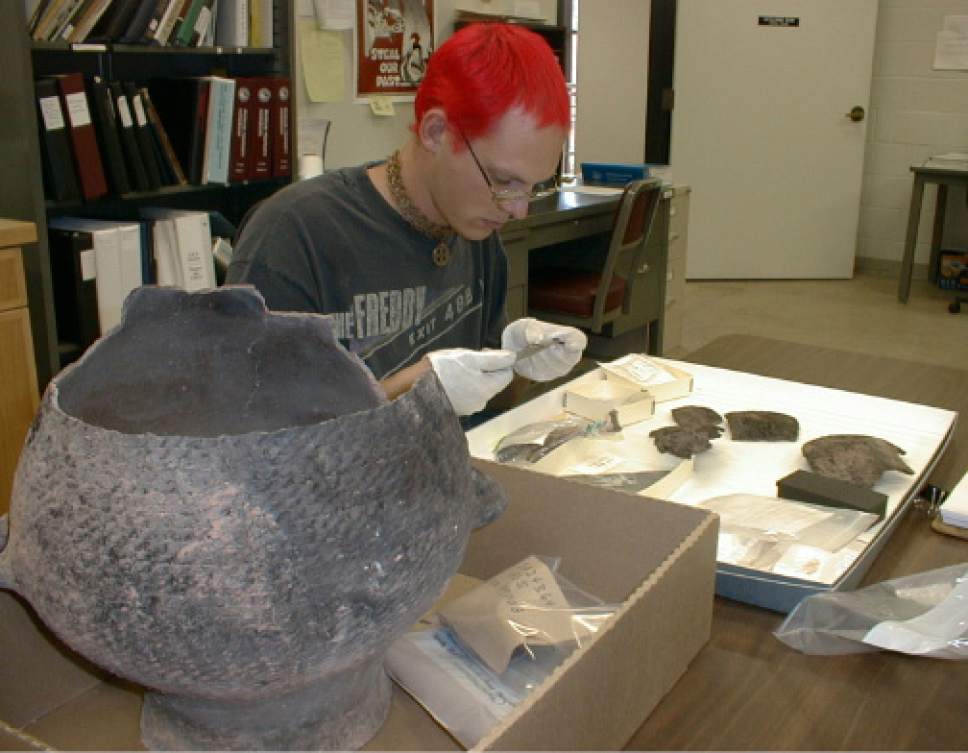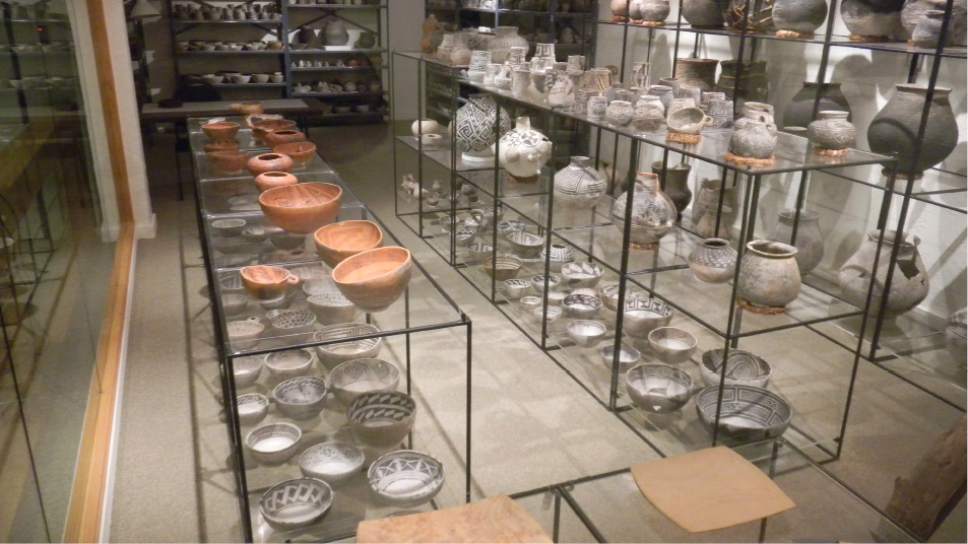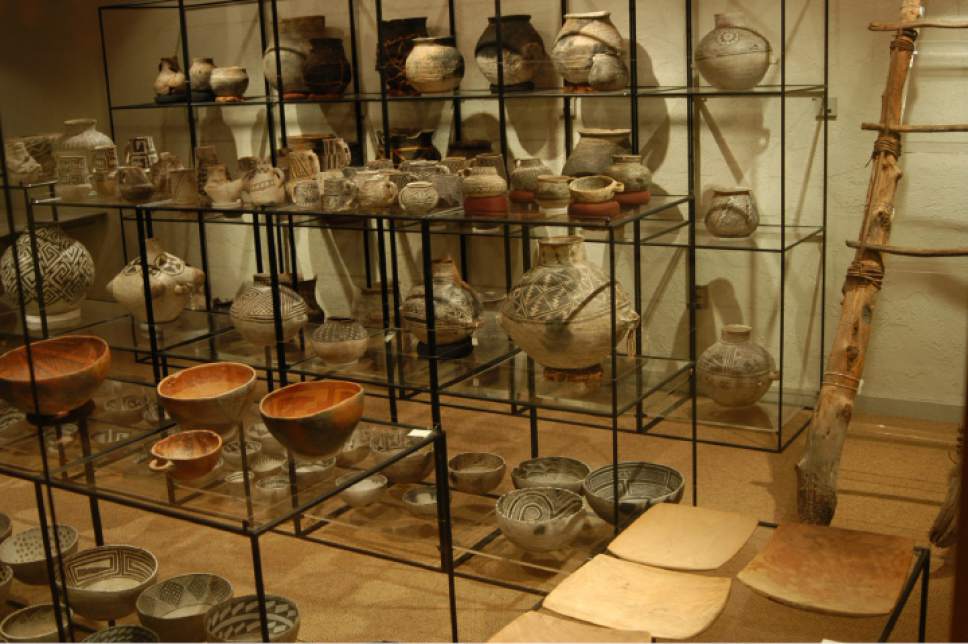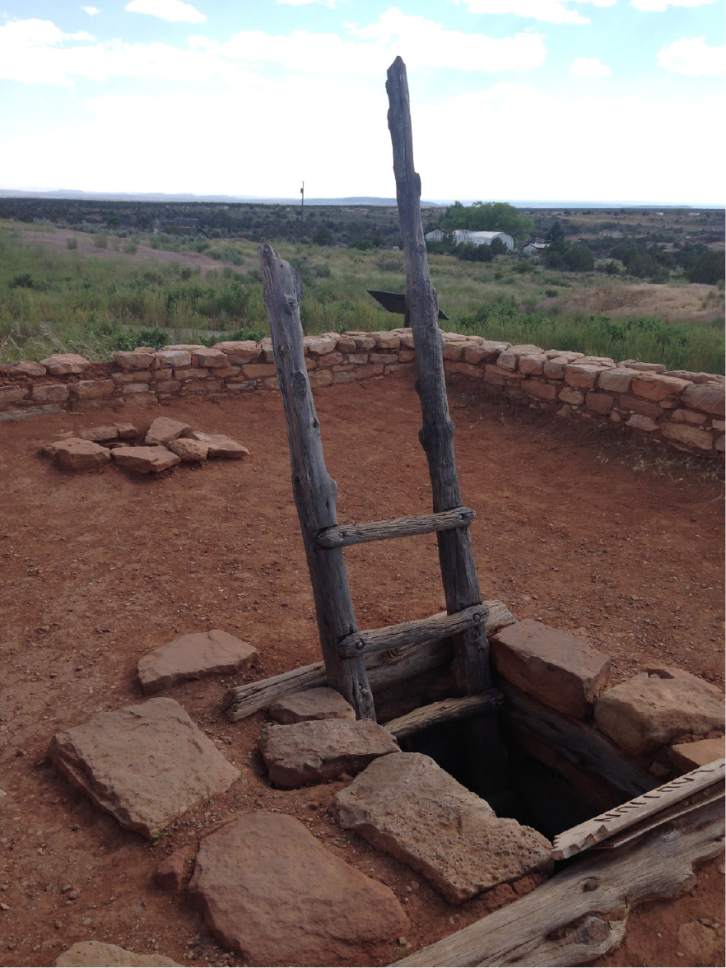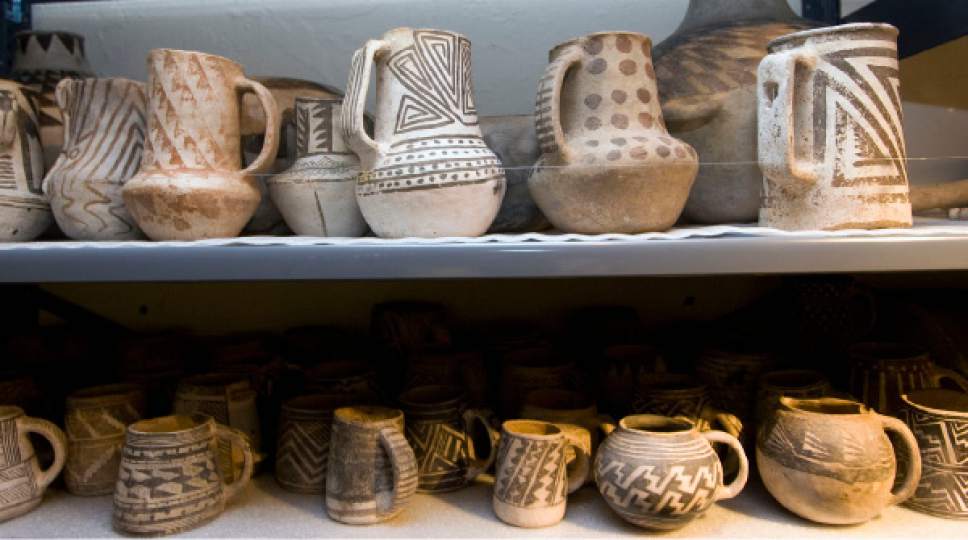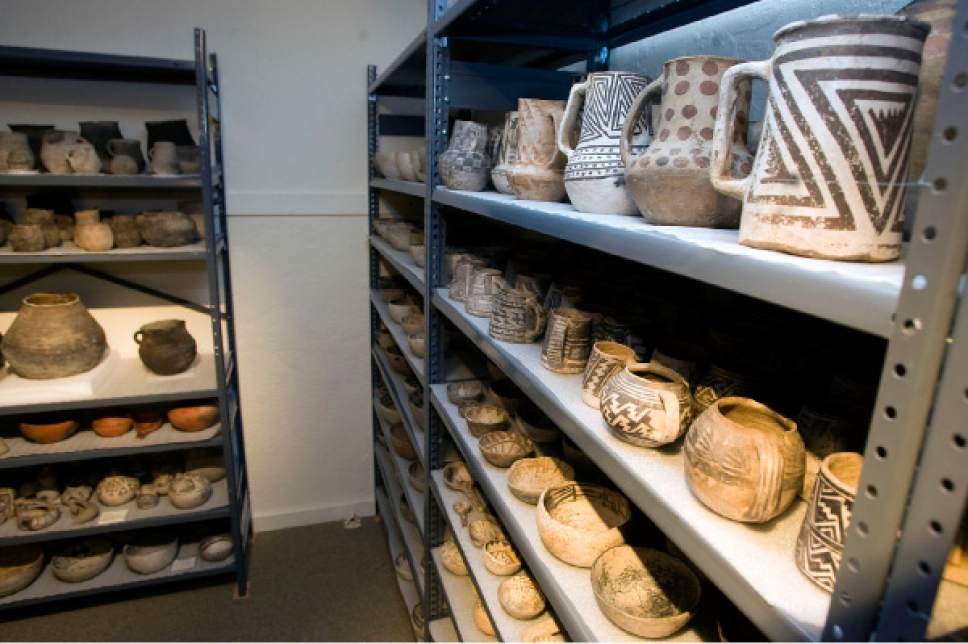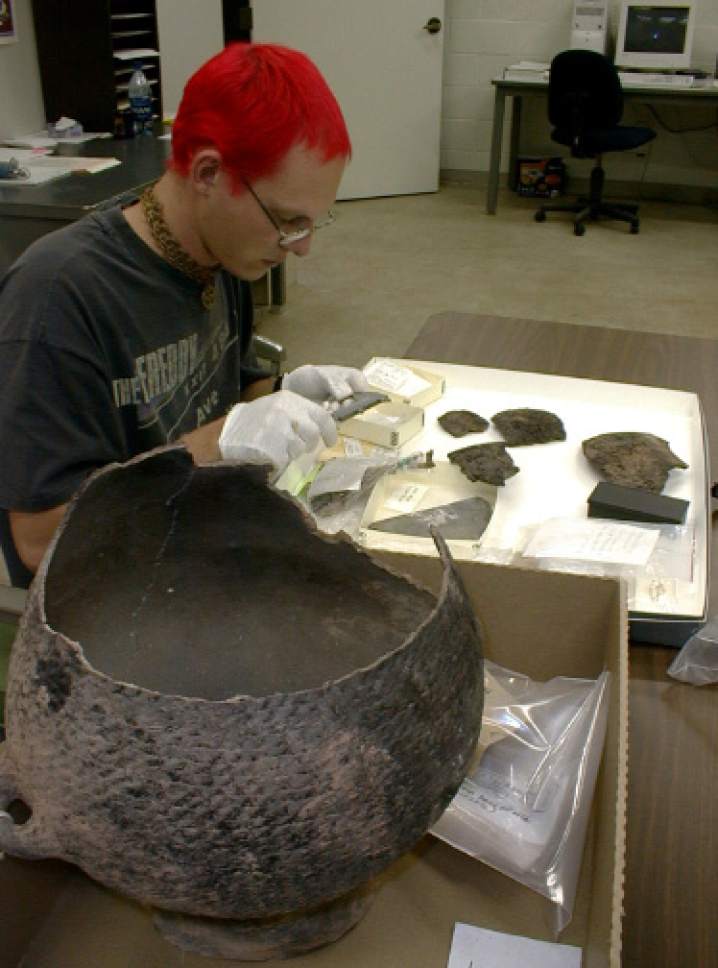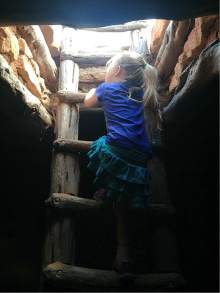This is an archived article that was published on sltrib.com in 2017, and information in the article may be outdated. It is provided only for personal research purposes and may not be reprinted.
Nearly 40 years ago, Utah's Edge of the Cedars State Park Museum received its inaugural collection of artifacts as a loan from the Utah Navajo Development Council, a now-dormant nonprofit set up to use tribal money on community-building projects.
It was a cache of Anasazi pottery that would be considered one of the most important assemblages of Ancestral Puebloan artifacts — except that they were probably illegally excavated and their provenance remains a mystery.
The loan may turn into a donation under a proposal now under consideration by the Utah Navajo Trust Fund, which "inherited" the pottery collection from the council years ago in the wake of an audit that excoriated the council's accounting practices and investments that did little to benefit local Native Americans.
The latest deal would transfer title of the so-called Shumway Collection, whose value is both priceless and worthless since the rare objects could never be sold in a legitimate market, to the state of Utah.
The status of the 960 pieces — largely intact ladles, pots, pitchers, bowls and other vessels — wouldn't change much. The pots would remain on display in the Blanding museum, which would have more options for sharing them with the public and researchers should it own the collection outright, according to Utah State Treasurer David Damschen, who by law heads the trust fund board.
Damschen noted that the fund is meant to promote the health, education and general welfare of Navajos living in San Juan County.
"Here we have this pottery collection that doesn't contribute to that in a clear way," Damschen said. "We think there are beneficial aspects to donating the collection to the museum."
The 1975 purchase of the artifacts was fraught with controversy that resonates to this day as Navajo tribal leaders debate what to do with the collection, which has been safely ensconced in the Edge of the Cedars State Park Museum since it opened in 1978.
Nearly all the pieces are on display in what museum officials call "visible storage."
Some feel donating the collection is the best option since it wouldn't cost the trust fund anything, while preserving the pottery in its present state. But others believe it should be moved to tribal headquarters in Window Rock, Ariz., to be placed in the care of the Navajo Historic Preservation Department, or displayed in a manner that would generate revenue for Utah Navajo communities.
One official said the debate has "opened a can of worms" for the Utah Navajo Trust Fund (UNTF) because the collection is so burdened with spiritual and political baggage, as well as competing ownership claims, that a resolution could be hard to reach.
The collection is named for an old Blanding family long involved with Puebloan artifacts, but these pots have little if anything to do with the most infamous member of the family. The target of a federal investigation in the 1980s, Earl Shumway looted archaeological sites without remorse and amassed an illegal trove, some of which is also held in the Blanding museum.
Rather, the collection came from Earl's uncle, a uranium miner named Eugene Shumway, and two of Eugene's brothers-in-law, one-time County Commissioner Jerry Holliday and Tim Perkins. The men never divulged to archaeologists where they found the pots, despite overtures from federal prosecutors that disclosure would not be used against them.
Documents indicate the items all came from San Juan County and date from A.D. 500 to 1300, the period when Ancestral Puebloan culture thrived then vanished from Cedar Mesa, now part of Bears Ears National Monument. It is assumed the items were removed from graves, where the Anasazi, the ancestors of today's Puebloan tribes, deposited treasured pottery with their dead. Few pots that were not buried survived intact through the centuries.
In 1975, Shumway, Perkins and Holliday sold their collections to the UNDC for $45,000 in a deal orchestrated by the then-executive director Cleal Bradford, a longtime local official. The idea was to lend the artifacts to the Utah Division of State Parks and Recreation for the museum under development on the west edge of Blanding. A contract requires the museum to display the pieces and not move them without permission from UNDC.
Officials justified the deal under the presumption that tourist traffic to the museum would promote economic development, in turn, benefiting Navajos. But a 1991 legislative audit concluded this arrangement along with a host of other UNDC deals were either a waste or solely beneficial to San Juan County's non-Navajo population.
Because the Utah Navajo Trust Fund provided the money to buy the collection, the public entity took ownership when the UNDC went belly up. The two now equally share ownership, according to Damschen.
The trust fund, whose assets now exceed $70 million, invests royalties and other revenue from oil and gas leases on the Utah portion of the Navajo Reservation. The fund's three-member board takes its cues from a tribal advisory panel with representation from each of the Navajo Nation's seven Utah chapters.
While the panel largely favors donating the pottery, opinions are mixed. Some believe the items have healing powers and shouldn't be on display, while others contend they hold negative spiritual energy that can sicken anyone who is exposed.
At a recent meeting of the advisory committee, one member suggested that the pottery was sacred and should be returned to the Earth.
"Why can't you put it back?" asked the woman, unidentified in an audio recording of the proceedings, conducted partly in Navajo. She told the committee her grandson, who was having frightening visions and wasn't eating, was cured by a traditional healer after drinking from such a vessel.
"It's not only history. It's who I am. It's my color," the woman said. "I tell my kids you are the same color as the Mother Earth because that's where we come from."
But other committee members noted the pottery was created not by Navajo ancestors, but by the nemesis they called Anasazi, and said the tribe should shed the collection once and for all.
Because of its negative connotations, the term Anasazi is offensive to many Zuni, Hopi and other Puebloan tribal members.
Meanwhile, Davis Filfred, a delegate representing some Utah chapters on the Navajo Nation Council, says the Navajo Utah Commission should have a say and perhaps the collection should be under the care of historic preservation officials in Window Rock, Ariz.
"If they want it, they should take it," said Filfred, who argued that would allow for adequately preserving the collection. "That is our culture. You are talking about heritage."
But Curtis Yanito, a Bluff artist who now serves as executive director of the Utah Navajo Development Council, has different ideas. He wants the council to retain ownership of the pottery, which he contends belonged to Navajo ancestors. Yanito is interested in displaying some artifacts at a facility proposed for Mexican Water, where visitors can be charged to see them.
"If we give it away," he said, "we won't have access to them."
But Damschen sees that idea as a financial dead end.
"The cost of constructing and maintaining a facility," he said at a March 23 meeting of the trust fund board, "would far outstrip any revenue potential."
Brian Maffly covers public lands for The Salt Lake Tribune. Maffly can be reached at bmaffly@sltrib.com or 801-257-8713.
Twitter: @brianmaffly


